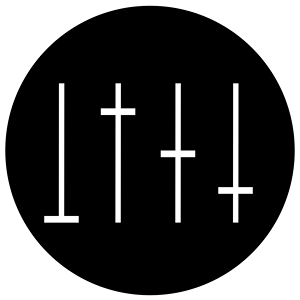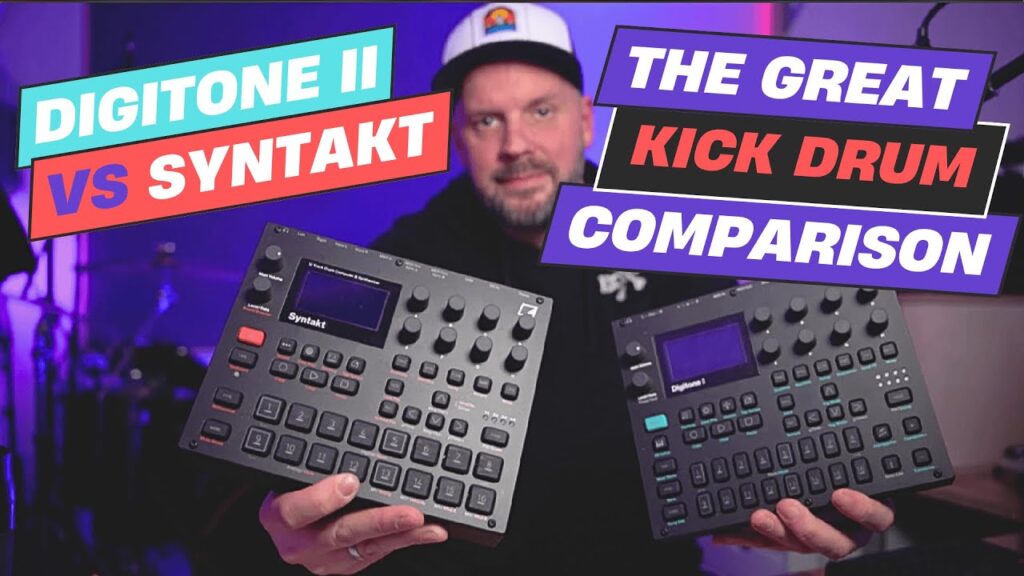Kick drums. The bread and butter of electronic music—whether you’re deep into techno, house, or other electronic stuff that blurs all the genre lines. In one of my previous videos, I compared the Elektron Syntakt and Digitone 2, and naturally, the conversation exploded around one core question:
„Which one makes the better kick drum?“
Some of you swore by the Digitone 2—others said it was clicky, thin, and just didn’t punch. Many leaned hard into the Syntakt’s analog drive and said, “That’s it. No competition.”
Well, let’s settle this. I’ve got both machines on the table, a blank project loaded into each, no compression, no analog drive (initially), no post-processing—just raw kicks. Let’s dive in.
What Makes a Kick Drum „Good“?
Before we go tweaking knobs, let’s agree on something: A solid electronic kick drum usually needs two core components:
- A strong, snappy transient to cut through the mix.
- A low-frequency decay that delivers the body, the weight, the sub.
That’s the blueprint. Let’s see how each device approaches that mission.
The Syntakt: Immediate Analog Satisfaction
The Syntakt is a hybrid beast—half digital, half analog—with an architecture built to make drum synthesis both powerful and surprisingly intuitive.
Starting with Digital: The BD Modern Machine
Even though it’s the only dedicated digital kick machine in Syntakt, BD Modern has surprising depth.
You get:
- Pitch sweep controls (adjusting the transient curve)
- Punch and decay shaping
- Square & triangle modulation
- Feedback, mod envelope
- And yes, overdrive
By tweaking just the sweep and punch knobs, I could already dial in something that felt club-ready. Add a little overdrive? Boom. Thick, forward, and musical. Too much? It’ll clip—but hey, maybe that’s your thing.
Tip: Add just a touch of modulation envelope for sharper control over the decay and attack.
Exploring the Analog Kick Machines
Syntakt really shows off here. You get six analog BD machines:
- BD Hard
- BD Classic
- BDFM
- BD Plastic
- BD Silky
- BD Sharp
- BD Acoustic (yes, seven if you count this modeled real-drum addition)
Each one has a vibe:
BD Hard & BD Classic
Both are aggressive. Classic gives you a tweakable transient knob that behaves similar to Digitone 2’s transient selection. Think punchy 909 vibes.
BD Silky
This one’s the sleeper hit. Long decay, soft edges—it’s your 808 trap monster. Add some dust (noise) and click for transient control. Perfect for hip hop or d&b rollers.
BD Acoustic
A newer addition aiming to mimic a real drum. Not my usual go-to, but for live-feeling setups, it’s solid.
Analog Drive Magic
Let’s be honest. Analog Drive is where Syntakt shifts gears. Dial it to 5? Your kick is instantly fatter. Go further and it starts to scream—in a good way.
Personal take: Syntakt kicks are easy to get right. Thick, warm, and they sit in the mix like butter.
Digitone 2: Sculpted Precision with FM Power
Now to the new kid—or rather, the evolved kid. The Digitone 2 comes with some serious upgrades, most notably: the FM Drum Machine.
And this one? It’s deep. If you love sound design, this is your sandbox.
FM Drum Machine – Let’s Break It Down
Page 1 gives you all the usual FM parameters: tuning, sweep time, feedback, wavefolding.
But it’s Page 2 and 3 that change the game:
- Split control between the transient and body of the sound
- A transient selector that lets you scroll through dozens of pre-shaped attacks: kicks, snares, claps, hi-hats, noise hits, even toms
This is insane. You can isolate and dial in just the transient without having to reshape the whole envelope manually.
Why That Matters:
In modern techno and house, we often want short, snappy kicks that don’t crowd the low end. This lets you build that minimal punch without unwanted boom. And you can always add the boom back in with body decay.
Pro move: Mute the body, find your ideal transient, then blend in just enough decay to ground it.
Filter Heaven
Digitone 2 includes:
- Legacy low/high-pass
- EQ filter
- Comp + and Comp – filters
- And yes, base-width filtering
You can shape the tone sculpturally—especially if you’re layering this in a dense mix. And that’s the key: shaping.
Unlike Syntakt’s plug-and-play thump, Digitone 2 asks you to build your kick. But in return, you get surgical precision and a clean, modern sound.
Final Verdict: It’s Not Either/Or
| Feature | Syntakt | Digitone 2 |
|---|---|---|
| Ease of Use | 🟢 Plug and play | 🟡 Needs sculpting |
| Sound Character | Fat, analog, aggressive | Clean, punchy, versatile |
| Transient Control | Basic (except BD Classic) | Deep, scrollable |
| Filter Design | Analog warmth | Surgical precision |
| Best For | Techno, live sets, analog heads | Tech-house, IDM, sound designers |
My Honest Take
If you want immediate, analog, club-ready kicks—Syntakt is your best friend. Especially with Analog Drive. It’s fun, fast, and hard to mess up.
But if you love control, variety, and being able to morph one kick into ten—Digitone 2 offers a sonic playground. The FM Drum Machine is a work of genius, and with some patience, you can shape it into anything.
Pro-Tip: Want the best of both worlds? Sample a kick from your Syntakt, bring it into Digitone 2, and sculpt around it with FM layers and filtering.
If you found this helpful, share the love. Subscribe, ring the bell, and let me know in the comments: What’s your go-to kick drum machine and why?
And hey, if you’ve been sleeping on Digitone 2’s transient selector—wake up. There’s gold in there.
See you next time

